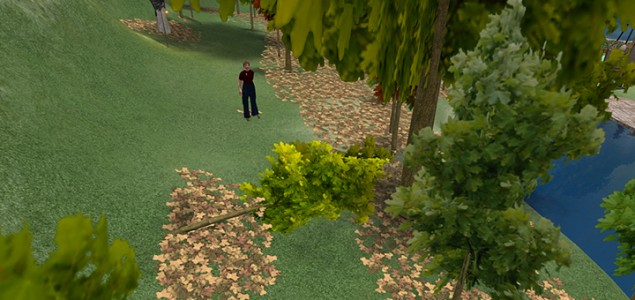If a tree falls in a virtual forest and no avatar is there to hear it, does it make a sound? Some may argue that a virtual world region must always be running, irrespective of an avatar presence, to be counted as a “real†region. Others would say that even if the region and the tree only exist when an avatar is present, the region is nonetheless “real†in every meaningful way, regardless of the state of the region between visits.

Kitely is an on-demand service that hosts regions in a unit of organization they call worlds. So, let’s see what makes them “realâ€â€¦
Reason #1: When you enter a Kitely world, you are using OpenSim
Kitely runs OpenSimulator to create regions within each Kitely world. Thus, by definition, Kitely worlds are “real†OpenSim regions. Okay, that was easy…
The key distinction with Kitely is that those regions are not kept loaded in RAM when no one is using them. Functionally, Kitely regions appear and behave just like any other OpenSim region on any other grid. The only user experience difference is the time delay for initial access to a world. Well, the Web was just as real using a 56k modem as using 40Mbps broadband service, so it really isn’t relevant to say that the speed of establishing a connection determines the realness of a service. And like improvements in accessing the Web, Kitely has been improving world startup times, in many cases reducing that time to mere seconds.
Reason #2: You can enter any Kitely world 24/7, conditional of course on any permissions that have been set
Kitely does have a rating system that restricts who can access specific worlds based on owner settings. And like other grids, Kitely supports access control via groups. Nonetheless, all Kitely worlds are accessible to someone, at any time, 24/7. How is that different than accessing any other “real†region on a 24/7 grid with similar owner controls?
Reason #3:Â The light in your refrigerator is a real light, even though it turns off when you close the door
Okay, so the argument is that if a world isn’t loaded into RAM 24/7 it doesn’t count as a “real†region.
That does mean that if I turn off the room light when I’m not in it, it’s not a “real†light?
That’s meaningless in any practical sense. As long as my service is there when I or someone else decides to use it, it’s just as “real†as a service burning watts when no one is around.
But I hear another argument as well, that people open an account and create a free Kitely world, which may lay idle, indefinitely; therefore it should not be counted as a “real†region.
But the point about whether a region is “real†is not about how often it is used, or the value of its content, but rather, is it accessible whenever a visitor or owner decides to visit? Regions in “always on†grids can sit idle for hours, days, even weeks at a time. Does that idle time running on a computer mean they shouldn’t be counted either, if no one is there and the regions go unused?
In fact, grids count those regions along with the more active ones.
Reason #4:Â Kitely doesn’t reserve map spaces for regions that don’t exist
One idea that has been bantered about is that after a certain amount of time of non-use, a world should be counted as “dead†and removed from region counts.
This argument usually comes up around the time that OSgrid does some housekeeping, so the comparison is made that like OSgrid, Kitely should do a similar cleanup.
However, the OSgrid system is a system of reservations. When those reservations go unused for a period of time, the addresses are reclaimed and the region count, which is actually a reservation count, goes down. When the count is adjusted, regions are not deleted, but rather unused reservations are reclaimed.
This does not happen at Kitely. Any world counted is a world that can be accessed. Kitely doesn’t need a cleanup process because worlds that are deleted are expunged from their system with no lingering region-less reservations to clean up later.
Reason #5: Reality is in the mind of the beholder.
Certainly one can argue philosophically and arrive at various definitions of reality. So, are regions examples of realism, nominalism or idealism? Is Kitely consistent with the paradigm of your choice? Defend. I’ll expect your essays by noon on Friday.
My hope would be that Kitely regions are readily accepted as inherently “real†enough for any reasonable standards virtual worlds users would typically apply. After all, when you get down to it, any implementation of “virtual reality†is already a challenge to what “real†means.
Bottom line
Can we agree that Kitely regions are “real� I haven’t found any reason to think of them as anything but real. Certainly for the people who use Kitely, their worlds are real.
Because of the on-demand service structure, Kitely also offers huge cost savings and a green approach to region hosting that has truly set them apart and attracted a lot of “real†virtual world projects; not only for hobbyists, but for schools and businesses as well.
There is a discussion worth having about the impact of regions in any grid that persist and are accessible, yet serve no visitors or even the world creator. It is, however, a complex topic with many considerations that go beyond the scope of this article.
The issue of “real†regions as described here does not make a value judgment about content, use or raison d’être. Rather, “realâ€, in relation to Kitely regions, simply means existing as accessible virtual places, which are in every way equivalent to the “real†regions offered by other services.
- Meta’s moderation change means more bad stuff will get through - February 25, 2025
- Virtual curating frees artist - April 16, 2024
- Apple and the bane of VR gentrification - February 3, 2024
